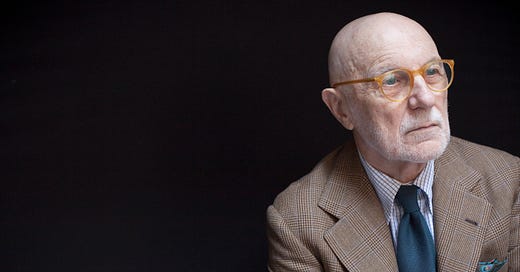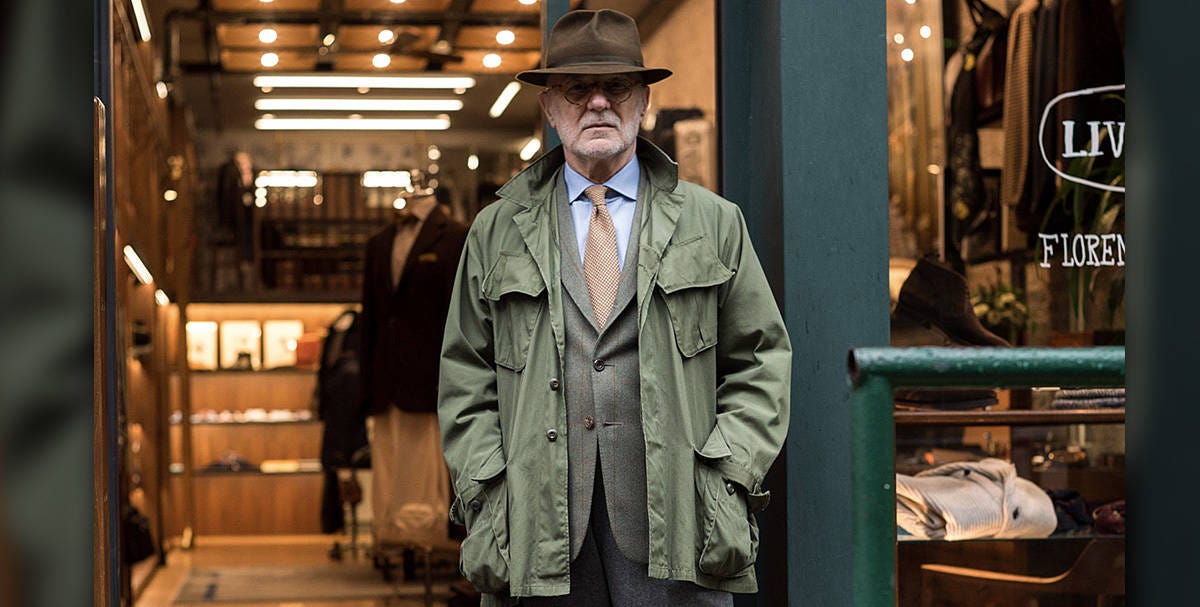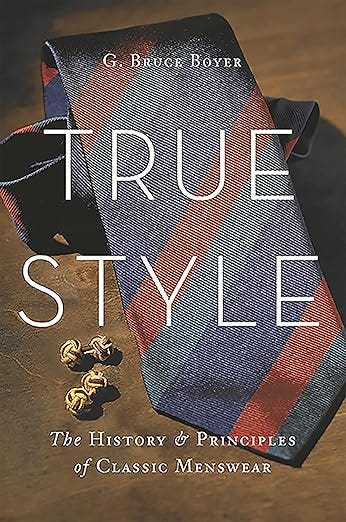The Style Is The Man: G. Bruce Boyer
After more than 50 years in the game, the menswear OG still has plenty to say (just not about navy blazers).
When I recently met G. Bruce Boyer for the first time, I asked him what he was up to. His response? “I’m not just nearly retired, I’m nearly dead!” It’s that kind of incisive wit that’s sustained a legendary career writing about menswear, and more, for decades, from the heyday of magazine journalism to today’s extremely online era. The men’s fashion editor at Town & Country for 15 years, Boyer has also contributed to the likes of Esquire, Harper's Bazaar, The New York Times, and The New Yorker, along with authoring several books on style and a collection of musings on the music of his youth, namely, jazz, blues, and early rock.
As knowledgable as he is gregarious, Boyer is a pleasure to speak with, so I called him up at his Pennsylvania home to find out how he stays motivated, hear a few stories from his high-flying magazine days, and get his take on menswear today.
After the release of “Riffs,” you told Put This On that you felt like the menswear well had sort of run dry for you. Can you explain?
“I had taken as my purview classic clothing, tailoring and bespoke clothing. The best tailors around and the best shoe makers and that kind of thing. I'd been writing about men's clothing since 1973 when I started at Town & Country, so after a good long while I discovered two things: One was that you get to an age where you both can't keep up anymore with the young Turks out there and you also kind of lose perspective. I mean, I think that's kind of to be understood that you are just not as in tune with the times as you would like to be, you know? You've gotta give way to the younger guys who understand the zeitgeist better. And being a writer, you start to lose the ability to come up with the telling metaphor because your points of reference now are all in the past.
The other point I guess that I'd like to make is, what do I want to say? I had to stop writing about navy blue blazers and the gray flannel suits because I thought if somebody asked me to do one more article about those things I would have to kill somebody.
Trying to write about a new subject, it refreshes you. It's like taking a vacation. You you come back with a new perspective on life and writing. It’s given a new perspective on my own writing, it's stretched me a little bit.”
What years were you at Town & Country?
“Off the top of my head, I'm thinking ‘73 to about ‘85.”
With the recent release of Graydon Carter's memoir, all these stories about the heyday of magazines have been in the news again, like Bryan Burrough getting half a million dollars to write three articles a year for Vanity Fair. Did you experience any of that golden age?
“Oh boy, did I?! Yeah, it really was great! First of all, at Town & Country the editor-in-chief was a man named Frank Zachary, he was already a legend when he came to [the magazine]. He was the guy who developed Holiday magazine and I think a couple of others; he was a brilliant, brilliant editor-in-chief. He brought in the best photographers in the world. I mean, everybody from Slim Aarons and Jonathan Becker to [Henri] Cartier-Bresson and Norman Parkinson. And I met all of those guys and worked with them. I styled shoots for them.
Now, this is the early ‘70s, it was not fashionable or popular to write about men's clothing. It seems funny today because there are maybe hundreds of blogs on men's clothing and numerous magazines. But there wasn't at the time. It was considered by a lot of publications that if you wrote about men's clothing it was effeminate. I tried to look at clothing, not in its own sake, but to tie it to the zeitgeist, to something bigger than the clothing itself.
At that time, you could get a press junket to anywhere in the world, first class. Oh, I went to more places! I went to Italy twice a year, I went to London twice a year. There was once a junket that I took where I stayed in every first-rate hotel on the French Riviera, from Saint-Tropez to Monte Carlo. They had a helicopter fly me from place to place.”
What do you think of menswear writing today?
“What occurs to me, first of all, is that there's a stylistic difference to the writing. When I went to Town & Country they kind of drilled it into their writers that there is only one rule, and the rule was that the story is never about you. If you were writing a story about evening wear—tuxedos, white tie and tails, whatever it was—that's what the story was about. The words ‘me’ and ‘I,’ those first person pronouns should never be in there. You are not the star of the story, you are just a writer. Today, I think it's completely the opposite.
I don't think either way is particularly right or wrong if it's done well, but I do see a lot of personal writing where they're writing about getting a pair of shoes made or something and it's all about the guy's experience. Now, that's all well and good, but who is the guy? Does he know what he's talking about? Is it good advice that we should follow? I see that all the time all over the internet, people are saying, well, you should do this and you should do that, but what's the source of the advice?”
Speaking of advice, I recently wrote about the growing frustration with always being told to find your personal style. What do you make of that?
“I think that these guys are right to question that. And to flip back to what I had just said, I think a lot of that is because they're getting a lot of bad advice. So much of it is ridiculous, and if you follow a lot of those guys and dress that way, you're gonna find it really doesn't work for you. It's almost harmful rather than helpful. Style is almost an impossible thing to talk about. It's one of those things where we say, I don't know what it is but I know it when I see it.”
Like the old definition of pornography.
“I think the reality of that it's so hard to discuss what that is. It's certainly hard to write about it. There are a lot of books, including my own, that talk about clothing in terms of how you should wear your clothes and so forth. But they're not talking about style, they're talking about propriety. I mean, you look at Alan Flusser books…I like Alan, Alan is a very stylish guy. But Alan is one of those guys who's into the rules, you know? If your pocket handkerchief is not folded a certain way, Alan won't even talk to you [laughs].
All of those rules are complete nonsense because styles change. If you say, well, your trousers should be a certain length one year that may be true as a description, but as advice it doesn't hold because next year they're gonna look like something else. So you can't talk about style in terms of rules. In fact, I think the guy who's stylish is the guy who learns the rules and then takes them and bends them to his own personality.”
I read a quote from you where you claimed that your personal style hasn't changed since you were 20. Is that true?
“Even earlier. I would say by the time I was 16 or 17 I had figured out who I wanted to be in terms of my character and personality, and that's what I dressed to show.
When we moved out of [a blue collar] neighborhood into a true middle class neighborhood, I went to a different school and met kids of a different class and I picked up on what they were wearing, which was Ivy League clothing. I think that has always been the basis of my dress, American Ivy League clothing. And then a little later on in the ‘60s, I picked up a little British Savile Row styling and a little Italian styling. I added a little British shaping into my garments and from the Italians I got a little color. And I think that's the way I've been ever since.”
We live in a hyper-casual world today. Have you ever been tempted to say, “screw it,” and just wear t-shirts, sweats, and sneakers?
“No, I've never done that. I did experiment a little bit when I was teaching, I'm gonna say from about 1965 to 1972. It was the time of hippiedom and flower power and that kind of thing. I did very quickly experiment with wearing Indian overshirts, bell bottom trousers, and letting my hair grow long. I realized almost instantly that it wasn't me.”
Taking the long view here, are there any lessons from menswear’s past that you think should be revisited?
“I do find something all the time that's not in the marketplace that I think ought to be there. For a long while I was very upset by trousers because every trouser had a very low rise. Skinny little trousers where they had like a four inch rise. It was what I called the ‘Pitti Uomo look,’ you know, those guys with the skinny little suits and Thom Browne and all of that. I think there's something very sociological about it all, men want to look like children or, I don't know what it is, I haven’t analyzed it.
Never has a style taken so long to die; I hated that. I was looking for khakis for years and years and years that had a high rise, a decently full leg, were a little tapered, and made out of a good sturdy cotton, and you just couldn't find them. Now they seem to be around, although very, very quickly, they're going in a bad direction, which is what fashion seems to always do. Trousers can only get so skinny before they start getting very wide again. And so now my problem is the opposite, the rise is too high, and they're too baggy. I'm a guy who believes in the golden mean.”








The only problem with this is there are too many quotes I’d like to re-stack! Another great post.
I agree that the new full cut khakis are too full cut. In the ‘90s I had a pair of high (but not too high) waist, flat-front khakis with a decently full (but not too full) leg and perfect taper. The fabric was really nice too, luxurious even. They were from Banana Republic. I wore them to death.